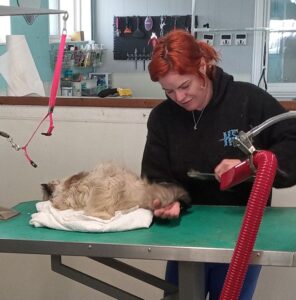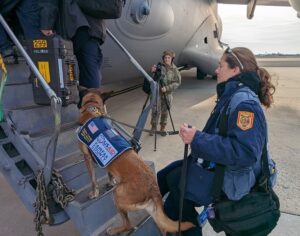 • American Psychiatric Association chat about pets, mental health
• American Psychiatric Association chat about pets, mental health
by Coco Lederhouse
Studies have found that interacting with animals can decrease levels of cortisol, reduce loneliness, and increase feelings of comfort and social support, according to Jen Brandt, PhD, AVMA director of member wellbeing initiatives. Pets can also serve as a bridge for social interactions, help you be more active, and reduce work-related stress.
According to a recent APA poll, nearly 90% of pet owners said their pet positively impacts their mental health. The chat started by addressing the ways pets improve our mental health.
“Pets can be a great source of affection, love, and loyalty,” Dr. Brendel said. “The APA was proud to collaborate with the AVMA and spotlight the important positive role pets can on our mental health, and the ways we can strengthen our bonds with our pets.”

Cats and dogs thrive with consistency and feel safe when we remain calm,” Brandt said.
Companion animals can aid with the treatment of diagnosed mental health issues, and for many people their pet has a large part in helping to manage their health.
Pets provide structure and a sense of purpose, a deep emotional connection that may not feel safe with other humans, reduce feelings of isolation due to stigma, and help distract from symptoms of illness.
• Don’t Give Over-the-Counter Medications to Your Pet
Dr. Lauren Forsythe, a pharmacist at the University of Illinois Veterinary Teaching Hospital in Urbana, shares her expertise about common medications that can be harmful to pets.
Pain Relievers: NSAIDs and Acetaminophen
Nonsteroidal anti-inflammatory drugs (NSAIDs) help to reduce pain, fever, and inflammation in humans. Common NSAIDs include aspirin, ibuprofen (e.g., Advil), and naproxen (e.g., Aleve).
“While veterinarians may sometimes recommend human over-the-counter medications for pets, many varieties of human medications are toxic to dogs and cats. Pain medications are among the most toxic,” says Dr. Forsythe.
Human pain medications are much more likely to cause toxicity in animals than they are in people, which is why there are veterinary-specific medications that are less toxic.
Acetaminophen (e.g., Tylenol) is not an NSAID. It relieves fever and pain but does not reduce inflammation.
“Acetaminophen should never be given to a cat,” says Dr. Forsythe. “Even an infant dose can cause severe adverse effects or potentially lead to death.”
Medications for Allergies, Nausea
Antihistamines such as diphenhydramine (Benadryl) are sometimes recommended by veterinarians. But, Dr. Forsythe warns, many commercial medications contain a variety of active ingredients. For example, certain products address several symptoms that can occur together, such as allergic reactions and nasal congestion or pain.
“Pet owners should consult with their veterinarian before giving any human over-the-counter medication to their pet. The veterinarian will know how to assess the pet’s potential underlying health issues, possible interactions with medications the pet already takes, and what the proper dose is for that particular pet,” says Dr. Forsythe.
Additionally, pet owners often want to treat their vomiting dog with a commercial medication. The main brands, including Pepto Bismol, contain bismuth subsalicylate, which is similar to aspirin. Products containing bismuth subsalicylate can have adverse effects in dogs and are not recommended.
Topical Antibiotics and Antifungals
Topical antibiotics may provide local benefits and avoid the problems sometimes associated with oral or injectable antibiotics. However, animals are likely to lick and groom themselves, which can turn a topical medication into an oral medication. Ingesting some topical medications could be very dangerous for pets.
In general, any wounds on your pet that might lead to infection should be seen by a veterinarian. A veterinarian will know which medications are safe and will stitch the wound, if necessary.
Similarly, a medical professional should be consulted regarding treatment for a fungal infection. The treatment will depend on the site and severity of the infection. Often, prescription oral antifungals are necessary when topical antifungals aren’t appropriate.
Why OTC Medications Aren’t for Pets
“Most over-the-counter medications are designed to treat symptoms, not the underlying cause,” says Dr. Forsythe. While humans and animals may experience similar symptoms, the underlying causes can be completely different. For that reason, what works for the symptoms in a person may not work in an animal.
There are also important differences between animals and people in how the body absorbs and metabolizes drugs. These differences can affect the efficacy of a medication as well as its toxicity.
Not only should you not give human medications to pets, but it is very important to prevent pets from accidentally ingesting medications.
“Keep all medications, especially flavored ones, out of reach of pets,” Dr. Forsythe recommends. “If you have a counter-surfing pet, you may need to keep medications inside a closed cabinet.” Even when the bottle is closed, an animal can chew its way in if something smells appealing enough.
Dr. Forsythe advises storing all medications in their original packaging in an upper cabinet located in a cool place without excessive moisture. Make sure your pet is not allowed to lick a topical medication that you have applied to yourself.
If you think your pet has ingested a medication unintentionally, contact your veterinarian or the ASPCA’s Animal Poison Control Center 24-hour hotline at (888) 426-4435.

•









